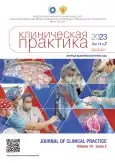A clinical case of drug-induced arterial hypertension caused by glycyrrhizic acid
- Authors: Antropova O.N.1, Osipova I.V.1, Silkina S.B.2, Obrazcova L.A.1
-
Affiliations:
- Altai State Medical University
- Consultative and Diagnostic Institute of the Altai Territory
- Issue: Vol 14, No 2 (2023)
- Pages: 120-124
- Section: Case reports
- URL: https://journals.rcsi.science/clinpractice/article/view/142804
- DOI: https://doi.org/10.17816/clinpract138628
- ID: 142804
Cite item
Full Text
Abstract
Background: In clinical practice, drug-induced arterial hypertension (AH) often remains undiagnosed, since the identification of an ethical disease in this form of AH avoids the initiation of antihypertensive therapy. A critical part in the differential diagnosis of hypertension and planning of long-term strategies for managing a patient requires a thorough study of the properties of the drugs taken and the pathophysiological mechanisms that depend on the increase in high blood pressure against the background of taking one or another substance.
Clinical case description: Assumption of pregnancy in a random 57-year-old Caucasian female patient with AH syndrome and history of AD crisis during the year. Against the background of two-component antihypertensive therapy, indapamide 2.5 mg + telmisartan 80 mg, increased blood pressure. From the anamnesis of life, it is noteworthy that the patient should keep records with a hepatologist; with a diagnosis of chronic viral hepatitis C with moderate activity, she takes Phosphogliv. Physical examination confirmed the presence of grade 2 hypertension; no signs of target organ detection were found. Laboratory and instrumental research showed cytolytic syndrome of minimal activity (AST, 74.8 U/l; ALT, 60.5 U/l), hypokalemia (K+ 2.1 mmol/l), unknown etiology, aldosterone within the normal range, metanephrine (80.4 pg/ml at a rate of <64 pg/ml), and normetanephrine (276 pg/ml at a rate of <176 pg/ml) in blood plasma are increased. MSCT of the kidneys and adrenal glands revealed no enlarged formations. Drug-induced arterial hypertension was clinically diagnosed. Concomitant diseases: Chronic viral hepatitis C, moderate activity. Varicose veins, venous infection of the extremities. Dynamics and outcome. After the abolition of glycyrrhizic acid, blood pressure and potassium levels in the blood plasma returned to normal, which is not recommended to take antihypertensive drugs.
Conclusion: An exceptional clinical situation is a pronounced manifestation of a rare side effect of glycyrrhizic acid in the form of drug-induced hypertension.
Full Text
##article.viewOnOriginalSite##About the authors
Oxana N. Antropova
Altai State Medical University
Author for correspondence.
Email: antropovaon@mail.ru
ORCID iD: 0000-0002-6233-7202
SPIN-code: 3539-2790
Dr. Sci. (Med.)
Russian Federation, BarnaulIrina V. Osipova
Altai State Medical University
Email: i.osipova@gmail.com
ORCID iD: 0000-0002-6845-6173
SPIN-code: 1904-5154
Dr. Sci. (Med.)
Russian Federation, BarnaulSvetlana B. Silkina
Consultative and Diagnostic Institute of the Altai Territory
Email: s.shel@mail.ru
ORCID iD: 0000-0001-8282-2574
SPIN-code: 3504-5041
MD, PhD
Russian Federation, BarnaulLolita A. Obrazcova
Altai State Medical University
Email: mob1977@mail.ru
ORCID iD: 0000-0001-5283-4996
SPIN-code: 7677-4383
Russian Federation, Barnaul
References
- Остроумова О.Д., Сычев Д.А., Кочетков А.И., и др. Лекарственно-индуцированная артериальная гипертензия // Медицинский алфавит. 2022. № 3. С. 8–13. [Ostroumova O.D., Sychev D.A., Kochetkov A.I., et al. Drug-induced hypertension. Medical alphabet. 2022;(3):8–13. (In Russ).] doi: 10.33667/2078-5631-2022-3-8-13
- Lovell AR, Ernst ME. Drug-induced hypertension: Focus on mechanisms and management. Curr Hypertens Rep. 2017; 19(5):39. doi: 10.1007/s11906-017-0736-z
- Grossman A, Messerli FH, Grossman E. Drug induced hypertension: An unappreciated cause of secondary hypertension. Eur J Pharmacol. 2015;763(Pt A):15–22. doi: 10.1016/j.ejphar.2015.06.027
- Foy MC, Vaishnav J, Sperati CJ. Drug-induced hypertension. Endocrinol Metab Clin North Am. 2019;48(4):859–873. doi: 10.1016/j.ecl.2019.08.013
- Falet JP, Elkrief A, Green L. Hypertensive emergency induced by licorice tea. CMAJ. 2019;191(21):E581–E583. doi: 10.1503/cmaj.180550
- Sontia B, Mooney J, Gaudet L, et al. Pseudohyperaldosteronism, liquorice, and hypertension. J Clin Hypertens (Greenwich). 2008;10(2):153–157. doi: 10.1111/j.1751-7176.2008.07470.x
- Serra A, Uehlinger DE, Ferrari P, et al. Glycyrrhetinic acid decreases plasma potassium concentrations in patients with anuria. J Am Soc Nephrol. 2002;13(1):191–196. doi: 10.1681/ASN.V131191
- Deutch MR, Grimm D, Wehland M, et al. Bioactive candy: Effects of licorice on the cardiovascular system. Foods. 2019; 8(10):495. doi: 10.3390/foods8100495
- Rajewski P, Zarębska-Michaluk D, Janczewska E, et al. Hepatitis C infection as a risk factor for hypertension and cardiovascular diseases: An EpiTer multicenter study. J Clin Med. 2022;11(17):5193. doi: 10.3390/jcm11175193
- Petta S. Hepatitis C virus and cardiovascular: A review. J Adv Res. 2017;8(2):161–168. doi: 10.1016/j.jare.2016.06.001
Supplementary files






